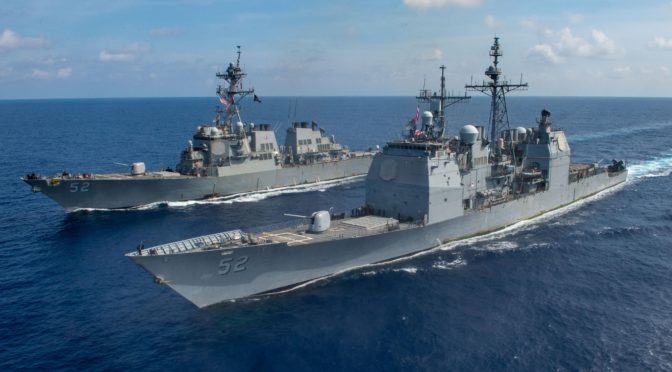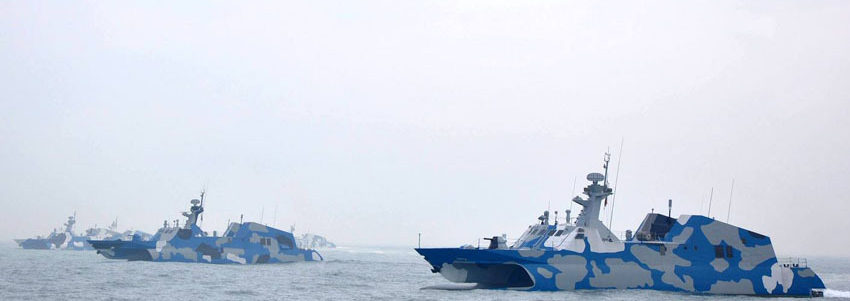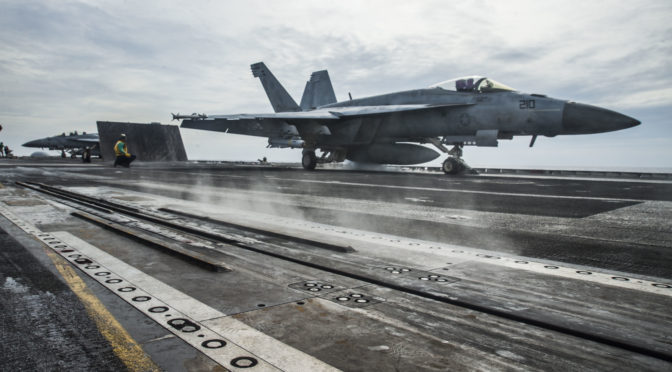Force Structure Perspectives Series
By Dmitry Filipoff
As a part of CIMSEC’s Force Structure Perspectives Series, CIMSEC discussed the Battle Force 2045 fleet design with Dr. John T. Kuehn, a retired naval aviator who serves as the Fleet Admiral Ernest J. King Visiting Professor of Maritime History for the Hattendorf Historical Center (HHC) at the U.S. Naval War College, and served on the Chief of Naval Operations’ 2016-2017 Fleet Design Advisory Panel. In this conversation, Dr. Kuehn discusses the pitfalls of designing a fleet around a short war, the historical context behind earlier fleet design efforts, and why naval leadership sometimes needs a push from Defense Secretaries to go in the right direction.
The Secretary of Defense recently announced a new fleet plan for a future U.S. Navy of 500 ships, a major increase over today’s fleet of around 300 ships. Among many changes, the fleet emphasizes substantial additions in areas such as sealift, unmanned warships, submarines, and smaller surface combatants. What do you make of the size of this fleet and its mix of platforms?
I recently penned an article about the U.S. Navy’s attempts to “right size” over 115 years ago, when the fleet numbered just over 300 ships. Unlike today, the fleet was steadily growing, but there were voices that claimed it was big enough to do what the American people wanted, such as to protect trade and enforce the Monroe Doctrine in the Western Hemisphere. The title was “no magic” number, and as mentioned by Trip Barber on this forum, I think we all need to keep from thinking there is some absolute in terms of numbers. “How many ships do we need?” is really the wrong question. There is no magic number. Naval officers always want more—more money, more ships, and more time.
The better questions have to do with what our maritime interests are, both for the U.S and for its alliance structures (NATO and in the Pacific), and how do we modify the existing fleet to address those interests, whether in peace or in war. Can the fleet we have today do that? Can the system we have in place to change fleet structure be responsive enough to self-correct?
That said, the capabilities the plan wants to leverage seem the right sort of mix, and it represents a better approach to both an actual conflict breaking out as well as a deterrent to prevent that conflict. This last seeming contradiction is the great paradox of military and naval power and it causes no end of resentment by amateur strategists who have difficulty understanding that preparedness is indeed the best guarantor of peace. But there must be progress to make that happen, and if competitors read big words but see little action, they are likely to be emboldened rather than deterred.
I think the mix of platforms is a sensible one, and I am prepared to see a modest reduction, but not elimination, of the aircraft carrier force to get the ball moving. This does not mean I necessarily think the overall naval air force needs reduction. Again, we want our competitors to see results. I share the concerns about loss of budget share, but I think strong leadership by whoever the next president and Secretary of Defense will be should prevent that.
The undersea components are the ones most likely to have significant impact for the near-term fight or its deterrence. I am on the record in a number of places—including CIMSEC—about building more submarines as well as maintaining core anti-submarine warfare capabilities in the fleet.
This new force structure may be used to execute Navy and Marine Corps warfighting concepts, including Distributed Maritime Operations (DMO), and Expeditionary Advanced Base Operations (EABO). These concepts and the new fleet design embody leadership’s thinking on the nature of future warfighing tactics and operations. Are these warfighting concepts mature or flexible enough to provide a long-term foundation for building this redesigned fleet? Are trends in tactics and technology adequately captured?
Distributed maritime operations that enable what is termed “distributed lethality” hinge on certain factors. In the first place, the fundamental vision should be for an approach that is enabled and enhanced by what some are calling the new capital ship, “the network.” But getting to that point requires enough resilience—a buzzword I do not use lightly, maybe robustness is better—in the force to be able to fight in a highly chaotic electromagnetic and cyber environment that will be degraded once the missiles and electrons start flying.
An important element to manage this risk is tactical mission command, and empowering subordinates at the scene of action to exercise initiative. But there is a catch. Nelson’s advice that “no captain can do very wrong in placing his ship alongside that of the enemy” must be updated to include the unmanned battlefield. Does this mean no drone operator, or operator(s) on a mothership, can do very wrong in placing these systems in a position to inflict lethal damage to enemy systems? Quite right. However, at what point do they trust the algorithms? A culture of micromanagement that wishes to monitor every weapon and engagement cycle is counterproductive to such an approach, and will stand as an obstacle to these nascent warfighting concepts.
As for the Marines and EABO, if the concept is more than just updated offensive methods, but a more holistic doctrine that includes defense, then it has promise. Everyone forgets that the first doctrine for Marine advanced base operations in World War II was really a defensive doctrine—at Wake Island and then again at Guadalcanal on a much larger scale (remember, the Marines landed unopposed at Guadalcanal). But I see few scenarios out there that might merit seizing advance bases rather than defending those we and our allies already control in what the Chinese call the first and second island chains. The next fight that is most likely to occur is in the seas around Taiwan, not the South China Sea.
I am concerned that the foot is being cut to fit the shoe in this case, or might the need for the Marine Corps as presently configured be an item that needs closer examination? It is not only the icon of the aircraft carrier that needs reexamination, but its amphibious counterpart, the Amphibious Readiness Group (ARG). As for applications outside the Pacific, we already have force packages with mature doctrine for most of the Marine Corps missions we might envision elsewhere. I am talking about things like non-combatant evacuation operations (NEO). ARGs are better suited to an expeditionary spectrum of war in the current environment.
The light carrier force in the Battle Force 2045 plan seems to be coming out of the ARG force structure with the America-class ships. As with the amphibious assault ships, I do not favor elimination, but reduction, modest reduction, of the ARG numbers—or repurposing as discussed in the Esper plan. But those remaining ARGs do need examination—what are they for? If they are simply to be advanced base “first responders” in a very lethal environment – that might not work out so well. So my question for EABO is: advanced bases where and under what circumstances?
I am not convinced that we really need to do much more to develop a force to establish advance bases in the Pacific. Our alliances there have already done that. Our need for such bases is not nearly as urgent as some may think.
The Navy has long been concerned about whether it can sustainably increase the size of the fleet within traditional levels of shipbuilding funding. How can we view the affordability and sustainability of this fleet?
Underrating the cost of sustainability is a chronic issue in force structure assessment. In a report of mine to Chief of Naval Operations Admiral John Richardson in 2017, I referenced the Congressionally mandated fleet structure reports from 2016, one by MITRE Corporation, one by the Center For Strategic and Budgetary Assessments (CSBA), and one an in-house study by the Navy (OpNav).
In that report to the CNO, I mentioned how one of the most telling comments I heard was, “Whatever fleet we build, it must have readiness built into it as part of the plan.” I noted that the three reports were weak in addressing long-term logistics and supportability issues, although CSBA’s did make some effort in its discussion of how to use fleet logistics (e.g., oilers). I continued on to say that this was a great concern because the existing budget paradigm has led the Navy to the point where it risks becoming a hollow fleet due to fragile readiness, as was the case after Vietnam in the 1970s. And if the geopolitical risks are assessed to be low, then this is not such a big problem, but when the Embassy in Teheran was seized, the poor readiness of all the U.S. military services’ forces came into sharp focus.
I concluded to the CNO that I would take a smaller, more ready fleet than a larger, unready one. In 1914 we had a large fleet with plenty of battleships, cruisers, and destroyers, but not nearly the trained people to crew them, never mind all the trained crews for destroyers that we needed to fight submarines when war did come in 1917.
I would add that we were weak in our ability to logistically support the 1914 fleet outside the Western Hemisphere. We had a similar situation in 1941 with a Pacific Fleet that simply did not have enough fast oilers (although we were trying to remedy that), but we had gotten the cart before the horse, or rather forgotten that we needed more carts.
Any expansion or change in fleet structure and size has to include the second and third order requirements for maintenance, trained personnel, logistics, and parts support. Designing around winning a short war as some have mentioned works against this. It is always better to plan for a long war, that way, as in Afghanistan and Iraq, we will not be caught short.
This process was notable for including the direct involvement and direction of the Office of the Secretary of Defense, which initially rejected the Navy and Marine Corps force structure assessment delivered in January. What is unique about how this process played out and what can we learn for making future assessments?
Others have already pointed out some of the historical context that informs the uniqueness of this approach. It has not always worked out so well with Secretaries of Defense in the past “pulling rank” on the Navy. Recall that in 1949 a Navy Secretary resigned and a CNO was relieved by the SECDEF in the so-called “Revolt of the Admirals” over the cancellation, of all things, of the construction of a super-sized aircraft carrier, the USS United States, as well as the neutering and reduction of naval aviation. Only the outbreak of the Korean War reversed this trend and brought some sensibility back into naval building policy and structure. I might add the Korean War also saved the Marine Corps from a permanent reduction in its size. I don’t think we should count on the serendipity of unexpected wars to solve our force structure problems.
That said, in this case I think the Secretary of Defense is correct. My own view is that the Navy and Marine Corps have an overly romanticized view of aircraft carriers and amphibious warfare based on World War II. In some sense, they are having cultural difficulties overcoming their history and answering the “why do we need these ships?” questions for today.
There is often no help from the top because of policy confusion over places like the South China Sea, the Senkaku Islands, and Taiwan. When policy is confused, answering the question of what to do with the fleet becomes even more difficult than it already is. The crystal ball becomes a black hole. In Esper’s case, it seems there is more policy clarity with respect to prioritizing China. His adoption of a different approach to fleet design, if it is sustained in the next couple of administrations (and that is a big if), can at least begin to give naval leaders new “sailing instructions.”
Another case study comes from my research. In 1922, naval leaders were again forced to go in a direction against their advice and collective will with the Washington Naval Treaty, which they did not like because it cut down the size of the fleet and instituted a battleship building “holiday” for ten years. Imagine an aircraft carrier building holiday (for all nations) for ten years today! Nonetheless, the Nay’s admirals grudgingly began designing a new fleet and I argue that they – and the fleet they designed – were better for it.
Sometimes naval leaders need to be pushed in the right direction. Sometimes they don’t (as in 1949). In this case, I think Esper is pushing them in a better direction than they were going with the status quo.
What does it mean for U.S. naval strategy and great power competitiveness to build this fleet, and to build it soon? Does it address a gap between national strategy and the navy needed to execute it?
I think the building it “soon” concept is a message that will be undermined by subsequent events. We may send an unintended negative message of a lack of resolve if it appears we have a new plan, but we have no political will to see it through, especially with regard to China. But if our competitors see us making real progress with real change, that message will be received.
However, saying we will do it quick is gratuitous and counterproductive. We simply do not have the shipbuilding capacity or the budgetary flexibility to do any of this quickly, even if we get to reprogram billions of dollars from carrier construction. And while some of the components have the potential to be fielded a bit more quickly, there is still much to be learned and experimented with. We have to be careful about how we do this.
Trying to do this quickly can amount to counterproductive sloganeering. And doing it quickly in the hopes of the aforementioned, magical short victory solution is historically a chimera. The short war “masters” of the past—Napoleon and the Nazis—lost in the long run, didn’t they? I would also lump the Imperial Japanese Navy into that category.
Previous force structure assessments conducted in 2016 were later considered by some to be overly optimistic with respect to certain factors, such as available resourcing. How can we be confident in this new assessment, and that it will spur the change it recommends? What comes next to build this fleet?
When I took a look at all three of those 2016 force structure studies and analyzed them, I found that perhaps the most optimistic of them, the CSBA study, still had the most promise. But it was not perfect—it discounted the capabilities of the other services (especially the U.S. Air Force) and allies. So this new assessment has to include the larger U.S. defense force structure, as well as our allied capabilities. Too often we plan in an American-only maritime vacuum.
What we do know, and have known for over 10 years now, is that the status quo, especially with a surging China at sea, is a long-term loser. If we keep doing what we are doing, with whatever assessment we say is guiding our path, then the taxpayers—and I believe the global community—will be poorly served by a legacy fleet instead of an updated fleet designed for the problems of this century, not the last one.
I am not overly optimistic, but neither am I totally cynical. The problem has made it to the Defense Secretary level, but if it fades after the election into business as usual, I think we will all lose. And by “we” I mean the American people and the people of allied nations.
Dr. John T. Kuehn currently serves as the Fleet Admiral Ernest J. King Visiting Professor of Maritime History for the Hattendorf Historical Center (HHC) at the U.S. Naval War College. He retired from the U.S. Navy in 2004 after 23 years, serving as a naval flight officer who specialized in airborne electronic warfare. In 2016-2017 he participated as a member of then-CNO Admiral John Richardson’s Fleet Design Advisory Panel. He authored Agents of Innovation (2008), A Military History of Japan: From the Age of the Samurai to the 21st Century (2014), Napoleonic Warfare: The Operational Art of the Great Campaigns (2015), America’s First General Staff: A Short History of the Rise and Fall of the General Board of the Navy, 1900-1950 (2017) and co-authored Eyewitness Pacific Theater (2008) with D.M. Giangreco as well as numerous articles and editorials, and was awarded a Moncado Prize from the Society for Military History in 2011. His latest book from ABC-CLIO is The 100 Worst Military Disasters in History (2020), co-authored with David Holden. He is the former Major General William Stofft Chair of Historical Research (2013-2016) at the U.S. Army Command and General Staff College. The views are those of the author and do not reflect the official policy or position of the Department of the Navy, Naval War College, Department of Defense, or the U.S. Government.
Dmitry Filipoff is CIMSEC’s Director of Online Content. Contact him at Content@CIMSEC.org.
Featured Image: SOUTH CHINA SEA (March 15, 2020) The aircraft carrier USS Theodore Roosevelt (CVN 71) leads ships from the Theodore Roosevelt Carrier Strike Group and the America Expeditionary Strike Group during a transit of the South China Sea during a photo exercise, March 15, 2020. (U.S. Navy photo by Mass Communication Specialist 3rd Class Brandon Richardson/Released)





